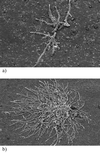Fungal colonization and biodeterioration of plasticized polyvinyl chloride
- PMID: 10919769
- PMCID: PMC92133
- DOI: 10.1128/AEM.66.8.3194-3200.2000
Fungal colonization and biodeterioration of plasticized polyvinyl chloride
Abstract
Significant substratum damage can occur when plasticized PVC (pPVC) is colonized by microorganisms. We investigated microbial colonization of pPVC in an in situ, longitudinal study. Pieces of pPVC containing the plasticizers dioctyl phthalate and dioctyl adipate (DOA) were exposed to the atmosphere for up to 2 years. Fungal and bacterial populations were quantified, and colonizing fungi were identified by rRNA gene sequencing and morphological characteristics. Aureobasidium pullulans was the principal colonizing fungus, establishing itself on the pPVC between 25 and 40 weeks of exposure. A group of yeasts and yeast-like fungi, including Rhodotorula aurantiaca and Kluyveromyces spp., established themselves on the pPVC much later (after 80 weeks of exposure). Numerically, these organisms dominated A. pullulans after 95 weeks, with a mean viable count +/- standard error of 1,000 +/- 200 yeast CFU cm(-2), compared to 390 +/- 50 A. pullulans CFU cm(-2). No bacterial colonization was observed. We also used in vitro tests to characterize the deteriogenic properties of fungi isolated from the pPVC. All strains of A. pullulans tested could grow with the intact pPVC formulation as the sole source of carbon, degrade the plasticizer DOA, produce extracellular esterase, and cause weight loss of the substratum during growth in vitro. In contrast, several yeast isolates could not grow on pPVC or degrade DOA. These results suggest that microbial succession may occur during the colonization of pPVC and that A. pullulans is critical to the establishment of a microbial community on pPVC.
Figures
References
-
- American Society for Testing Materials. ASTM standards on materials and environmental microbiology. Philadelphia, Pa: American Society for Testing Materials; 1985. pp. 178–180.
-
- American Society for Testing Materials. ASTM standards on materials and environmental microbiology. Philadelphia, Pa: American Society for Testing Materials; 1985. pp. 174–177.
-
- Andrews J H, Harris R F, Spear R N, Gee W L, Nordheim E V. Morphogenesis and adhesion of Aureobasidium pullulans. Can J Microbiol. 1994;40:6–17.
-
- Berk S, Ebert H, Teitell L. Utilization of plasticizers and related organic compounds by fungi. Indust Eng Chem. 1957;49:1115–1124.
Publication types
MeSH terms
Substances
Associated data
- Actions
- Actions
- Actions
- Actions
LinkOut - more resources
Full Text Sources
Medical
Molecular Biology Databases
Miscellaneous


